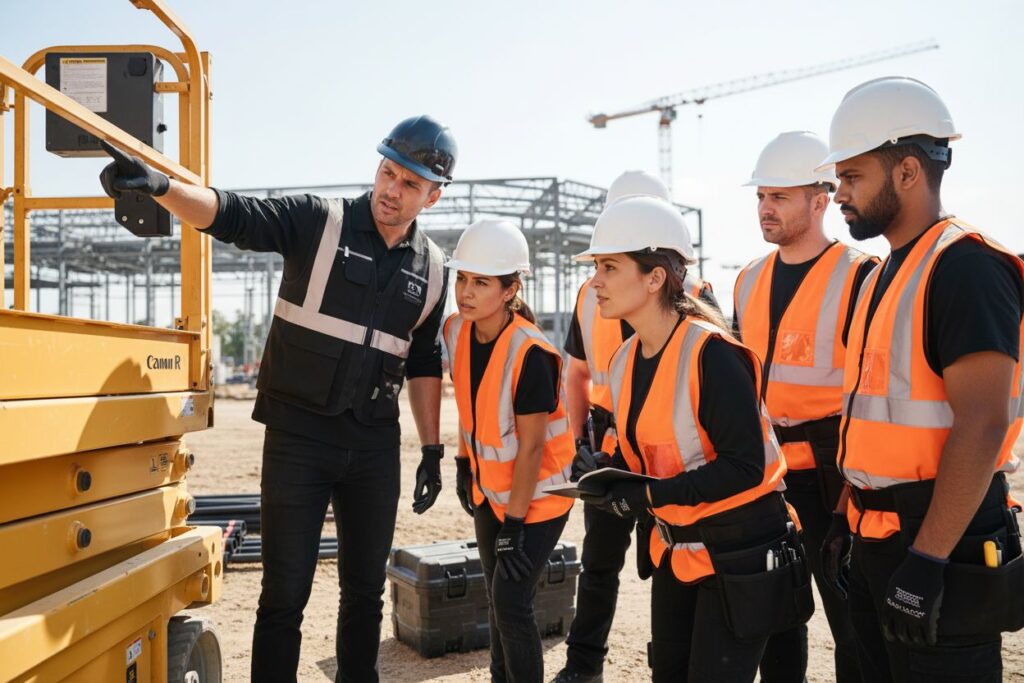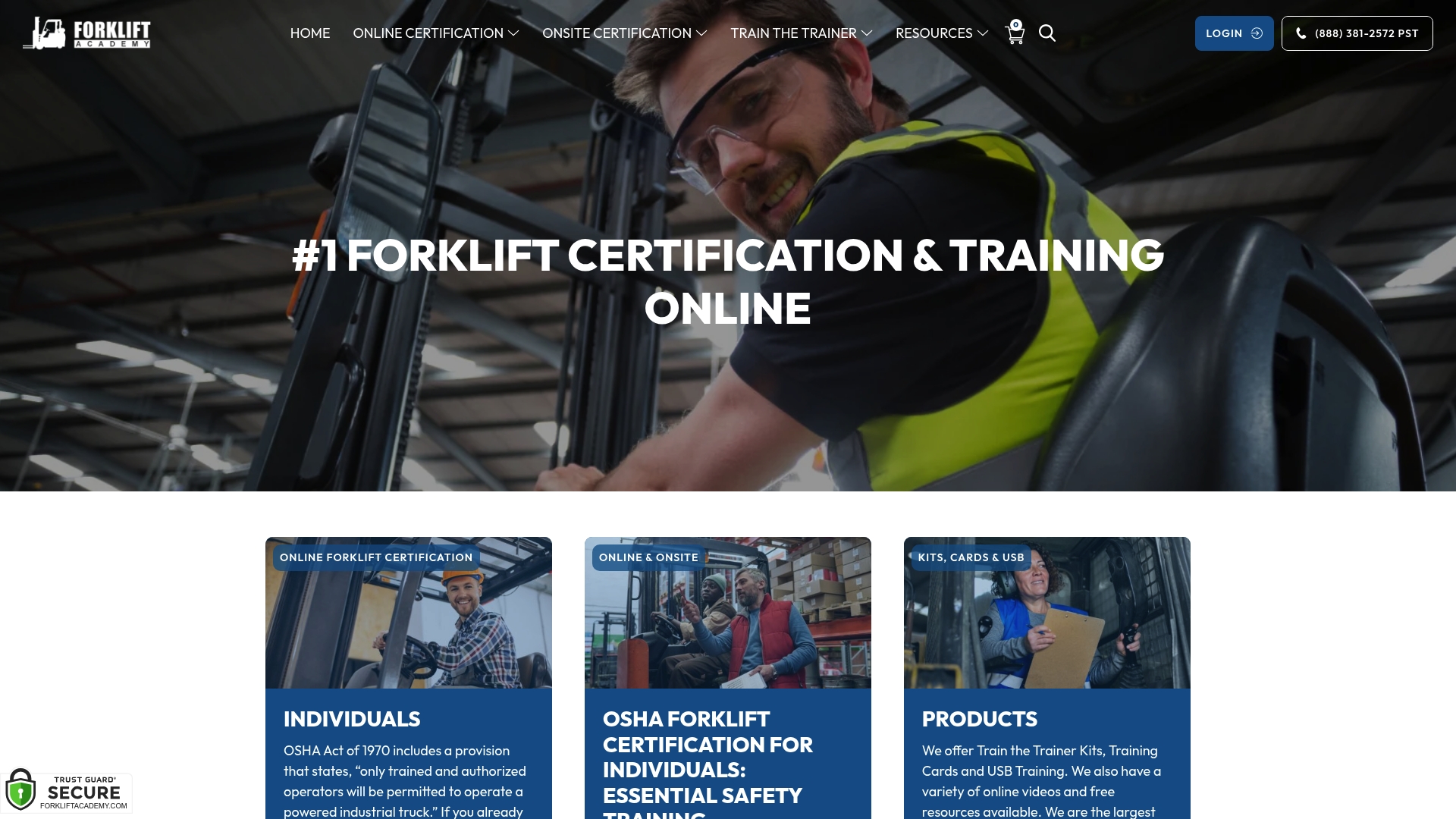
Nearly 70 percent of all scissor lift accidents are linked to improper training or unsafe operation, a statistic that highlights the real stakes of working at height. Whether you oversee job sites or step onto elevated platforms yourself, understanding every detail about scissor lifts could be the difference between routine safety and critical risk. Gain knowledge you can trust for equipment choices, inspections, safe use, compliance, and life-saving protocols.
| Takeaway | Explanation |
|---|---|
| 1. Select the right scissor lift | Assess work site conditions and job requirements to choose the appropriate lift type for safety and efficiency. |
| 2. Follow OSHA training standards | Mandatory training covers equipment usage and safety protocols to prevent workplace accidents. |
| 3. Conduct thorough pre-operation inspections | Inspect all components meticulously to ensure equipment is safe and functional before use. |
| 4. Utilize fall protection gear | Always wear and properly attach personal protective equipment to mitigate fall risks. |
| 5. Have an emergency plan in place | Develop and practice emergency response strategies to ensure effective reaction to potential hazards. |
Scissor lifts are essential mobile work platforms that enable workers to reach elevated heights safely and efficiently. According to OSHA guidelines, these unique machines use crossed beams to move vertically, distinguishing them from other aerial work platforms by their straight up and down motion.
Types of Scissor Lifts depend on specific job requirements and working conditions. Professionals typically encounter three primary variations:
Selecting the right scissor lift matters significantly. Learn more about scissor lift operator responsibilities to ensure you choose equipment matching your specific work environment. Each type has unique weight capacities, platform sizes, and movement capabilities that directly impact worker safety and project efficiency.
Practical tip: Always assess your work site conditions before selecting a scissor lift. Consider factors like surface terrain, available space, required lift height, and maximum worker weight to guarantee optimal performance and safety.
OSHA takes scissor lift safety seriously by establishing comprehensive training standards that protect workers at every operational level. Understanding OSHA standards for scissor lifts begins with recognizing the critical regulations that govern workplace safety.
Training Requirements are not optional recommendations but mandatory compliance protocols. According to ANSI standards A92.3 and A92.6, operators must receive thorough training covering multiple critical areas:
The core objective of these standards is preventing workplace accidents. OSHA specifically classifies scissor lifts under scaffolding regulations including codes 29 CFR 1910.28 and 1926.454. This means your training must comprehensively prepare you to recognize and mitigate potential risks.
Practical advice: Employers are legally responsible for ensuring workers receive proper certification. Always request documented training that meets OSHA compliance standards and covers all essential safety protocols. Your life and the lives of your coworkers depend on thorough understanding and implementation of these critical safety guidelines.
Before raising a single inch, scissor lift operators must perform a comprehensive pre-operation inspection that could mean the difference between a safe workday and a potential disaster. Scissor lift safety rules underscore the critical importance of thorough equipment assessment.
Inspection Checklist involves multiple critical steps that protect both the operator and surrounding workers. According to OSHA guidelines, your inspection should cover:
Professional inspections go beyond a quick glance. They require methodical assessment of each component. You want to confirm that every mechanism works precisely as intended. This means testing emergency stop buttons, checking battery levels, and ensuring safety interlocks function correctly.
Practical tip: Document your inspection findings. A written record protects you legally and creates accountability. If equipment fails inspection, immediately tag it out of service and report issues to your supervisor. Remember: no project deadline is worth risking your safety. A five minute inspection could prevent a life changing workplace accident.
Scissor lift operation requires more than technical skill it demands a comprehensive understanding of safety protocols that protect you and your coworkers. What is scissor lift training goes far beyond basic equipment handling.
Critical Safety Techniques focus on preventing potential workplace accidents. According to OSHA guidelines, operators must master several key operational strategies:
Understanding potential hazards is crucial. Most workplace scissor lift accidents occur from operator error or environmental misjudgment. This means recognizing risks like uneven terrain, overhead obstacles, electrical interference, and unexpected surface changes before they become dangerous situations.
Practical tip: Your safety depends on situational awareness. Before raising the platform, survey your entire work environment. Identify potential obstacles, understand load limitations, and communicate with ground personnel. Remember that no task is so urgent that it cannot be completed safely. When in doubt about operational conditions stop and reassess your approach.
Fall protection represents the most critical aspect of scissor lift safety where proper equipment and training can mean the difference between life and death. Understanding scissor lift operator responsibilities begins with comprehensive personal protective gear and fall prevention strategies.
Essential Safety Equipment includes more than just a harness. ANSI standards mandate comprehensive protection that covers multiple potential hazards:
Training goes beyond simply wearing equipment. You must understand how to properly connect your fall protection system to the scissor lift anchor points. Most serious accidents happen when operators assume equipment automatically protects them without proper attachment and usage techniques.
Practical tip: Inspect your personal protective equipment before every single shift. Look for signs of wear fraying or damage that could compromise safety. Your protective gear is your last line of defense against potential workplace accidents. Never use equipment that shows any signs of potential failure no matter how minor the issue might seem. Your life is worth more than saving time or avoiding equipment replacement.
Emergency situations can escalate quickly with scissor lifts especially when operators are unprepared. Understanding OSHA standards for scissor lifts means developing a comprehensive emergency response strategy that protects you and your coworkers.
Critical Emergency Protocols require systematic and immediate action:
Training teaches operators that emergency response is not just about individual survival but team safety. Understanding potential failure scenarios helps prevent panic during actual incidents. This means knowing how to recognize early warning signs of equipment instability such as unusual vibrations uneven platform movement or unexpected control responses.
Practical tip: Develop a mental checklist for emergency scenarios before starting any lift operation. Practice emergency lowering procedures during training and understand your specific lift model’s unique characteristics. Remember that quick rational thinking saves lives. Your ability to respond systematically under pressure could prevent serious workplace accidents.
Your scissor lift certification is not a one time achievement but an ongoing professional commitment to workplace safety. What is recertification represents a critical aspect of maintaining your operational credentials and ensuring continuous skill development.
Documentation Requirements are more than administrative paperwork. ANSI and OSHA mandate comprehensive record maintenance that protects both employers and employees:
Retraining becomes necessary under specific circumstances. This includes changes in workplace hazards equipment modifications observed unsafe practices or following any workplace incidents. The standard recommendation is comprehensive retraining every three years to ensure operators remain current with evolving safety protocols and technological advancements.
Practical tip: Treat your certification as a living document. Proactively seek opportunities for skill enhancement and stay informed about industry safety updates. Your commitment to continuous learning not only protects your professional credentials but potentially saves lives in high risk work environments.
Below is a comprehensive table summarizing the key types, safety standards, and operational guidelines for scissor lifts discussed in the article.
| Topic | Description | Key Considerations |
|---|---|---|
| Scissor Lift Types | Electric, Rough Terrain, Hydraulic lifts designed for specific environments like indoor, uneven ground, and heavy tasks. | Match lift type to environment for safety and efficiency. |
| OSHA Training Standards | Mandatory protocols including equipment manuals, inspections, and safety practices. | Compliance is crucial for preventing accidents. |
| Pre-Operation Inspection | Involves examining controls, brakes, wheels, and hydraulic systems. | Document findings and “tag out” faulty equipment. |
| Safe Operating Techniques | Maintain three points of contact, avoid moving lift raised, and be aware of surroundings. | Situational awareness is key to preventing accidents. |
| Fall Protection Equipment | Includes harness, lanyard, boots, hard hat, and gloves. | Inspect gear before use to ensure reliability and safety. |
| Emergency Procedures | Activate stop controls, lower platform, and communicate hazards. | Stay calm and follow systematic responses. |
| Certification and Retraining | Maintain records and recertify every three years. | Keep skills updated with changing standards. |
You have just learned how critical the right training, inspections, and certifications are for anyone stepping onto a scissor lift for the first time. Feeling overwhelmed by OSHA standards or unsure if your training fully prepares you for real-world hazards is common. Imagine the peace of mind that comes from knowing you or your team are 100 percent ready to handle every lift, every time. Visit our Forklift Safety Archive for experience-backed safety tips and practical guides that help bridge the gap from beginner knowledge to job site confidence.

Boost your safety and confidence today. ForkliftAcademy.com offers recognized forklift and scissor lift certification programs that meet OSHA requirements and can be completed on your schedule, online or onsite. Do not risk your future or the safety of your team. Choose fast, proven, and compliant certification now so you can keep your workplace protected and your career moving forward.
To effectively train as a scissor lift operator, focus on understanding equipment types, pre-operation inspection procedures, safe operating techniques, and emergency response protocols. Immerse yourself in each essential area during training to build a solid foundation for safe operation.
To meet OSHA training standards, ensure your training covers manufacturer manuals, safety features, and load capacity limitations. Document your training process thoroughly, and verify compliance before operating a scissor lift.
Your pre-operation inspection checklist should include checking the lift structure, testing operational controls, and verifying safety features like guardrails and brakes. Conduct this checklist every time before starting your work to ensure safety and compliance with regulations.
Essential PPE includes a full-body harness, safety glasses, hard hat, and non-slip work boots. Make it a point to wear all required gear each time you operate a scissor lift to safeguard against potential hazards.
Most experts recommend retraining every three years or whenever there are changes in workplace hazards or equipment modifications. Schedule regular refresher courses to stay updated on safety protocols and best practices in scissor lift operation.
In case of an emergency, immediately activate emergency stop controls and follow established evacuation procedures. Develop a mental checklist for emergencies before operations to ensure you and your team can respond calmly and effectively.